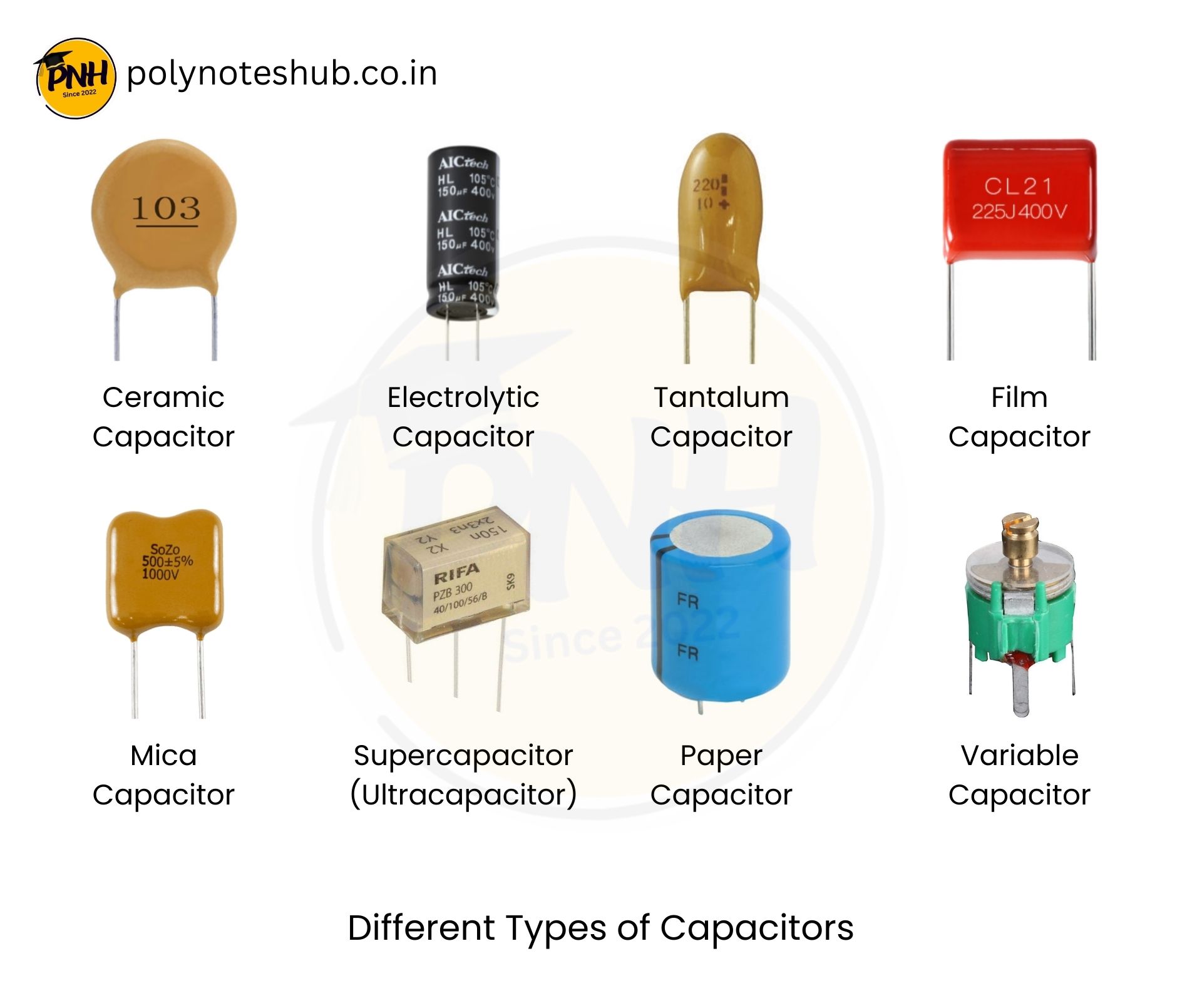In this note, we are going to learn about the different types of capacitors and their uses. The capacitors like ceramic, electrolytic, tantalum, film, mica, supercapacitor, paper capacitor, and variable capacitors.
Welcome to Poly Notes Hub, a leading solution for diploma and degree engineering notes for polytechnic engineering and degree engineering students.
Author Name: Arun Paul.
Different Types of Capacitors and Their Uses
If you are searching on the internet for How Many Types of Capacitors are available in Electronics, then you are in the right place. Here we have listed all types of capacitors and images of those capacitors, by which you will easily understand how those capacitors look.

Capacitors are vital electronic components that store electrical energy as an electric field. They’re commonly employed in power supply circuits, filters, oscillators, and electrical gadgets. Capacitors are classified into many varieties, each tailored for a specific application based on variables such as stability, capacitance range, tolerance, frequency response, and cost.
The following are the major types of capacitors, along with their definitions and separate tables.
1. Ceramic Capacitor
A ceramic capacitor is a non-polarized capacitor with a ceramic dielectric material. It is commonly employed in electronic circuits for filtering, bypassing, and high-frequency applications due to its reliability, low cost, and small size.
📌 To Know About Different Types of Ceramic Capacitor – Click Here
| Feature | Description | Use Case |
|---|---|---|
| Dielectric Material | Ceramic | High-frequency circuits |
| Capacitance Range | Few pF to several µF | Filtering, bypassing |
| Polarity | Non-polarized | Suitable for AC signals |
2. Electrolytic Capacitor
An electrolytic capacitor is a polarized capacitor with an electrolyte as one of its plates, providing extremely high capacitance values. They are often utilized in power supply circuits.
| Feature | Description | Use Case |
|---|---|---|
| Dielectric | Oxide layer | DC power supply |
| Capacitance Range | µF to thousands of µF | Smoothing, filtering |
| Polarity | Polarized | Not for AC applications |
3. Tantalum Capacitor
A tantalum capacitor is a type of electrolytic capacitor that uses tantalum metal to improve stability, reduce leakage current, and increase dependability.
| Feature | Description | Use Case |
|---|---|---|
| Material | Tantalum | Precise electronic circuits |
| Capacitance Range | µF range | Mobile devices, laptops |
| Characteristics | Stable, reliable | Space-critical circuits |
4. Film Capacitor
A film capacitor’s dielectric is a thin plastic film. They are non-polarized and noted for their high stability and extended life.
| Feature | Description | Use Case |
|---|---|---|
| Dielectric | Plastic film | High-voltage circuits |
| Stability | Very high | Audio, power electronics |
| Polarity | Non-polarized | AC applications |
5. Mica Capacitor
Mica capacitors use mica sheets as a dielectric and are noted for their high accuracy, insulation resistance, and dependability in high-frequency applications.
| Feature | Description | Use Case |
|---|---|---|
| Material | Mica | RF circuits |
| Stability | Excellent | High-frequency tuning |
| Capacitance | Low (pF level) | Precision circuits |
6. Supercapacitor (Ultracapacitor)
A supercapacitor is an energy storage capacitor with a very high capacitance. It stores energy using both electrostatic and electrochemical methods.
| Feature | Description | Use Case |
|---|---|---|
| Capacitance Range | Farads (F) | Backup power |
| Energy Density | High | Electric vehicles |
| Charge/Discharge | Very fast | Power delivery |
7. Paper Capacitor (Obsolete)
In a paper capacitor, the dielectric is waxed paper. It is mostly obsolete but was previously utilized in older electronic gadgets.
| Feature | Description | Use Case |
|---|---|---|
| Dielectric | Paper | Vintage electronics |
| Stability | Low | Old radio circuits |
| Polarity | Non-polarized | AC signals |
8. Variable Capacitor
A variable capacitor allows you to modify the capacitance manually. It is often used in tuning circuits, such as radios.
| Feature | Description | Use Case |
|---|---|---|
| Adjustment | Manual | Tuning circuits |
| Capacitance Range | pF level | Radio receivers |
| Polarity | Non-polarized | Frequency adjustment |

